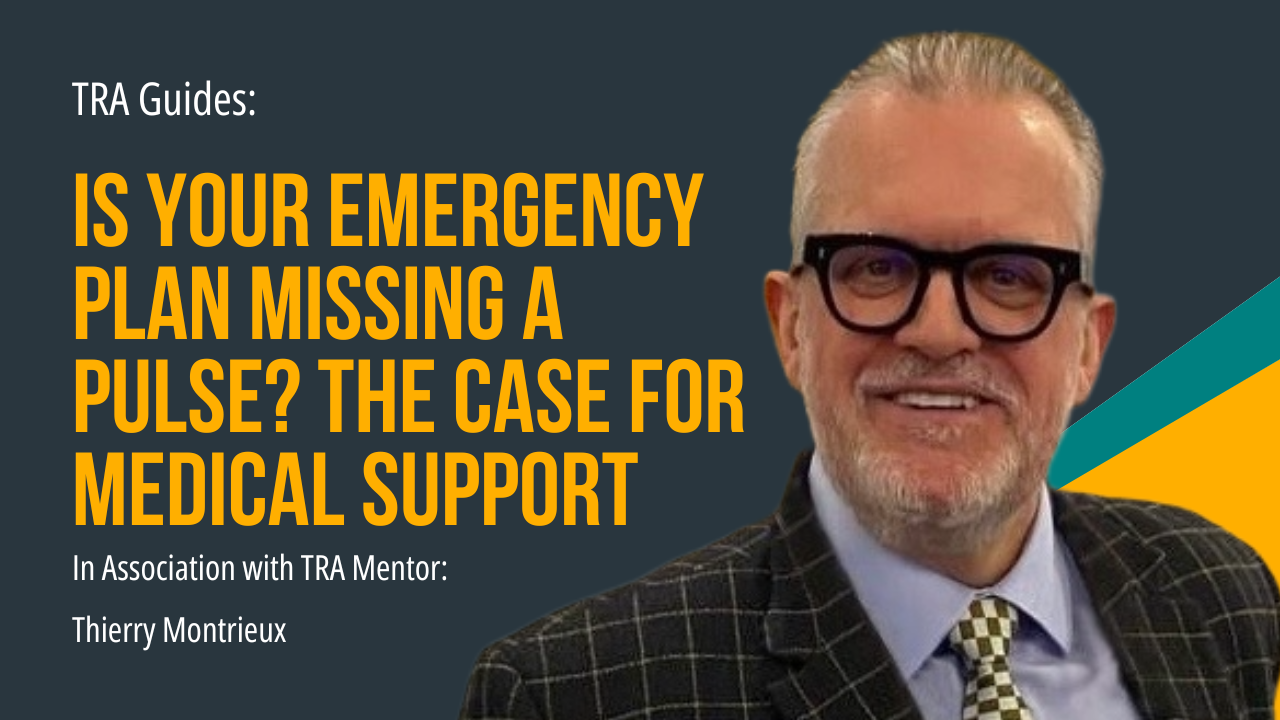Do Organisations including, Security Managers Forget About Medical Assistance?
Is that an insightful or inflammatory question? TRA Mentor Thierry Montrieux gives us his considered opinion and some trips on addressing it if the answer is anything other than NO.
Security managers focus heavily on threats like theft, violence, cyberattacks, or physical intrusions—but medical assistance can sometimes get overlooked by the organisations.
From my experience a few of the common reasons why this happens are:
- Perceived Scope of Responsibility
Many security managers view their role primarily as preventing security breaches, not handling health or safety. They assume medical emergencies fall under HR, health & safety, external emergency services or their designated emergency medical assistance company if one is appointed directly or via an insurance policy. - Training Bias
Security training often emphasises surveillance, access control, and emergency response for hostile threats. General first aid and medical response may be optional or underemphasised, so it doesn’t stay front of mind.
- Reactive vs. Preventive Mindset
Security teams often operate in a reactive mode, preparing for intrusions or incidents. Medical events (like heart attacks, asthma, or fainting) can feel less predictable and thus get pushed aside, even though they’re statistically more likely.
- Budget & Resource Allocation
Companies often allocate resources to visible security measures (guards, cameras, alarms) rather than medical preparedness (AEDs, first aid kits, staff training).
- Over-reliance on Emergency Services
Security managers sometimes assume that calling the emergency service is “enough,” forgetting that in many emergencies (e.g., cardiac arrest), the first few minutes of on-site response matter most.
- Cultural Factors
In some organisations, there’s a culture of separating “safety” and “security.” This silo effect leads to gaps in holistic emergency planning.
Statistically, medical emergencies are far more common in workplaces than violent intrusions, so integrating medical preparedness into security planning makes organisations safer.
Whilst there are no published statistics experience tells me for every 100 incidents around 99 will be for some sort of medical emergency ranging from the simple cut to the life threatening.
To help, I have put together some practical steps security managers can take to make sure medical assistance isn’t overlooked in their emergency planning:
1. Integrate Medical Response into Security Protocols
- Add medical emergencies (heart attacks, seizures, allergic reactions, injuries) into the same emergency response playbooks used for fire or security threats.
- Treat “first aid readiness” like fire extinguishers or CCTV — something that needs inspection, upkeep, and drills.
2. Train Security Personnel in First Aid
- Require at least basic First Aid, CPR, and AED training for all security staff. Build this into your TRM training package.
- Make refresher courses mandatory (skills fade quickly if not practiced).
- Encourage cross-training with health & safety teams.
3. Equip the Environment
- Ensure AEDs (defibrillators) and first aid kits are strategically placed and checked regularly.
- Include trauma kits (tourniquets, pressure bandages) in areas where workplace accidents or active threats are possible.
4. Improve Communication & Coordination
- Establish a clear medical emergency chain of command (who calls EMS, who assists the patient, who manages crowd control).
- Make sure any security guards know how to guide paramedics quickly to the scene (lost minutes in large facilities are critical).
- Who contacts the medical assistance company and when
5. Run Joint Drills
- Include medical scenarios in emergency drills (e.g., simulated heart attack in the lobby, choking in the cafeteria).
- Involve your medical assistance company or consult a medical assistance industry expert.
- This makes response smoother and reduces hesitation during real incidents.
6. Leverage Technology
- Some security systems can integrate with panic buttons or health monitoring wearables for lone workers.
- CCTV operators can be trained to spot medical distress (slumping, collapsing, seizure-like activity).
7. Break Down the “Silo Mentality”
- Collaborate with HR, health & safety officers, and local emergency services, your medical assistance company or consult a medical assistance industry expert.
- Security should see themselves not just as protectors from external threats, but as first responders in all emergencies.
By reframing “security” as protection of life first, vulnerabilities second, medical preparedness becomes a natural extension of the role.
Here’s a short checklist security managers could use directly in their planning, or more of a policy guide that could be adopted at an organisational level.
Security & Medical Assistance Checklist
1. Training
- All security staff trained in First Aid, CPR, AED use
- Regular refresher courses scheduled
- Cross-training with Health & Safety team
2. Equipment
- AEDs installed in high-traffic areas and checked monthly
- First aid kits fully stocked and inspected
- Trauma kits available where high-risk incidents may occur
3. Procedures
- Medical emergencies included in security protocols
- Clear chain of command for medical incidents
- Defined role for security: first aid, scene control, EMS escort
4. Drills & Coordination
- Regular medical emergency drills conducted
- Security staff know how to guide EMS quickly to incident location
- Coordination established with local hospitals/EMS
5. Communication & Awareness
- Emergency numbers posted and known to all staff
- Security can communicate calmly and clearly under stress
- CCTV/monitoring staff trained to spot signs of distress
6. Culture & Responsibility
- Security team recognizes role as first responders
- Medical preparedness seen as equal priority to threat response
- Collaboration with HR & Safety teams maintained
Never be afraid to seek, help, support and advice from people that have the experience to build the knowledge you need to provide the duty of care for your teams and staff.

